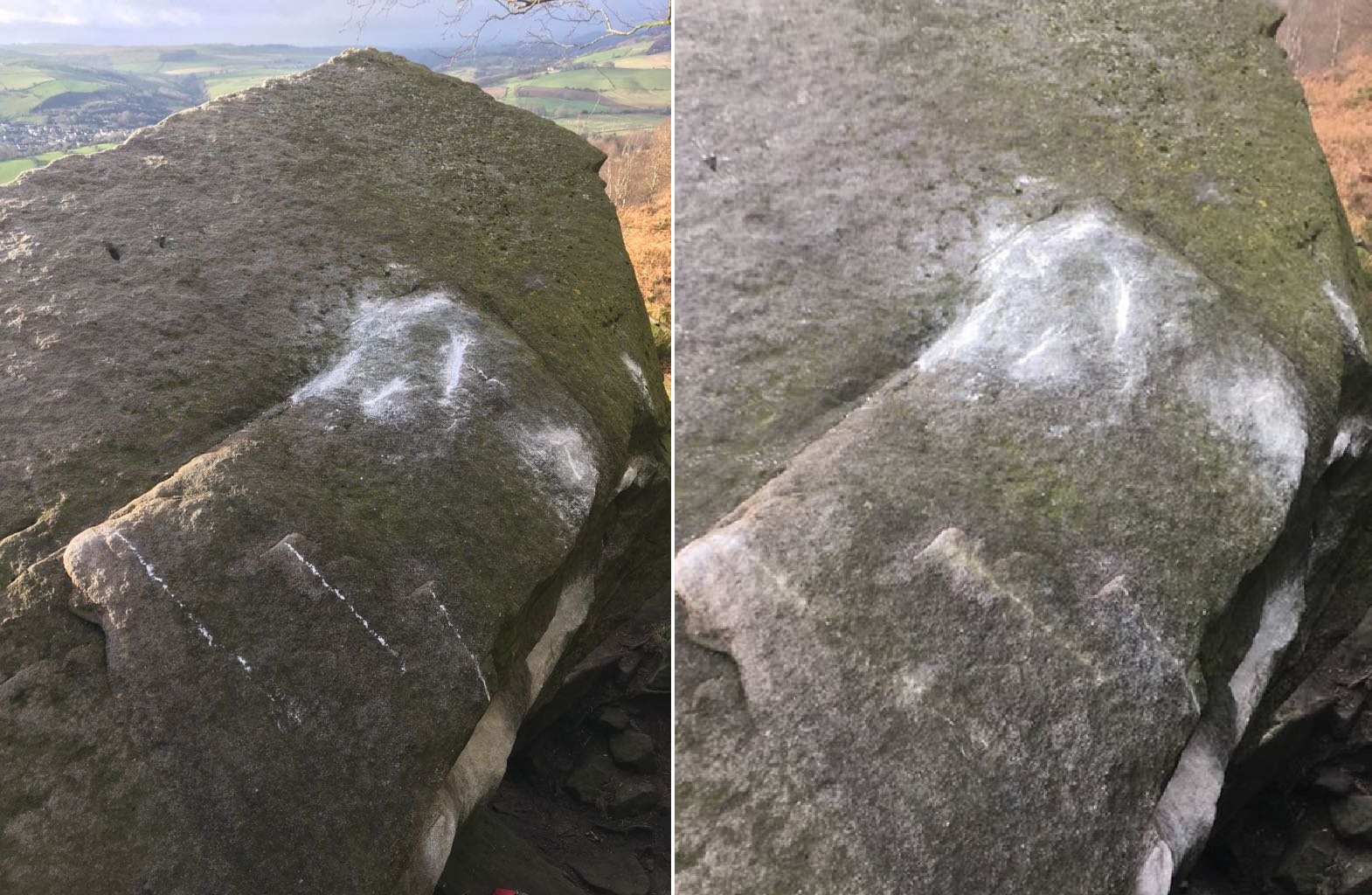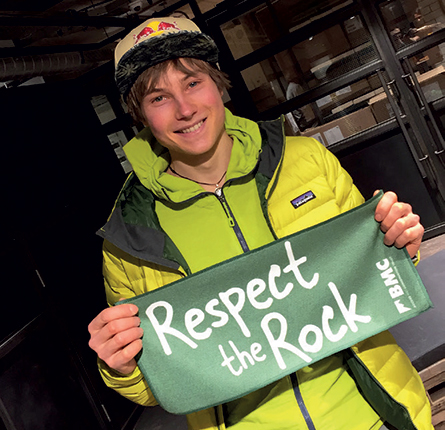Enter the church of crag and kneel before the altar of rock. Pay your respects, commit no sacrilege, and always follow the commandments found in the Book of Bouldering.
Palms are sweaty, knees weak, arms are heavy… what’s that on your sweater? Oh yeah, a snowstorm of chalk. We all use it, there’s no clean hand gang in this century, but it doesn’t take much to overdo chalk use, liberally plastering it on everything until the crag shines white in the night. Let’s take a step back and go over the six commandments of chalk.
Alongside rock shoes, a chalk bag and chalk are the next most used items of any climber. There’s no denying how useful it can be when you’re about to pull the crux, sweating, fingers creeping off holds. But a quick dab of chalk and, with dry fingers and confidence boosted, desperate suddenly becomes possible.
But chalk needs to be used in moderation – it stands out in natural landscapes and can detract from an otherwise wild experience to non-climbers. Rock caked in chalk is never a good look, and can lead to access problems.
So what should you do?
I: DON’T OVERDO IT!
Less is more. Too much chalk actually makes friction worse, so don’t go over the top. On porous or granular rock it packs out the natural roughness of the hold, making it slick and harder to hang or stand on. You only really need a light dusting to absorb the sweat and oil on your skin, but when you’re gripped, shoving your hands in your chalk bag, it often emerges covered in chalk. Take a second to blow off the excess – not only will you leave less chalk on the rock and have more skin-to-rock contact for better friction, but you can pretend to be a cool French too.
II: TICK MARKS
These help highlight out-of-sight holds so you can slap to them first time. If you can see the hold, why are you using a tick mark? Try to avoid enormous ‘donkey marks’ made by dragging chunks of chalk across the rock – a sure-fire way to get your handiwork noticed by people who could influence access to the crag. Instead of chalk, try using finger tape to mark holds – but be sure to remove them and bin them when you leave! If you must tick with chalk, try crushed chalk dabbed on your finger and keep the ticks small. Clean all tick marks with a soft brush and water if needed when you’re finished.
III: CHALK IS FOR HANDS ONLY
Chalk’s only purpose is to absorb sweat on your hands. It is not magic friction dust! In fact, excess chalk will reduce friction by preventing contact between the two surfaces trying to stick to each other – so chalking up shoes has the opposite effect to what you desire. The best way to get your shoes to stick better is to make sure the rubber is as clean as possible. Rub the sole of your boot until it’s squeaky clean. Equally, as mentioned above, chalking up holds only leads to build-up and packing out surface roughness, reducing friction. In short – only use chalk for your hands and make sure holds and shoes are as clean as possible for maximum friction.
IV: CLEAN OFF BEFORE YOU CLEAR OFF
When you’re finished, do a quick sweep of the area cleaning off any remaining chalk on the rock. Try and turn it into a ritual before leaving the crag, alongside the usual quick sweep for litter and gear. For most rock, a soft brush combined with a towel to waft loose chalk off the rock works well. When holds under overhangs on rock sheltered from rain get extensive build-up, from other climbers not cleaning up properly, sometimes the only option is to get stuck in with a bottle of water as well as a brush and towel. If everyone does their bit and cleans when they’re finished, it shouldn’t get to this stage though.

Before and after cleaning shows how left on chalk can mark the rock. Photos: David Mason
V: SOFT ROCK SPECIAL CONSIDERATIONS
On certain soft rock types – like southern sandstone or some of the less well bonded gritstone and sandstone elsewhere – even normal ‘soft’ brushes will unduly wear the rock. On this type of rock, it’s best to avoid needing to clean excess chalk wherever possible by limiting chalk use to the bare minimum, certainly avoiding chalk tick marks and giving eco-chalk (a Metolius product that doesn’t leave a white residue) a go.
VI: CHALK LITTER
Dropping empty chalk balls, chalk wrappers or leaving piles of loose chalk on the ground are all bad form and are only left by climbers. As with any litter, take it home with you and if you see rubbish that other people have left, do you bit to look after the places we all care deeply about and take it home as well.
THE FINAL SERMON
If I had to sum up everything above into a single line it would be this: aim to leave the crag in a better state than you found it, with as little evidence of climber’s presence as possible. We often talk about ‘leave no trace’ and when talking about chalk use this is particularly apt. Reduce the amount you use, be clever about how you tick holds and carefully clean the rock when you’re finished. The result will hopefully be nicer crags and boulders to climb on for everyone, reduced visual landscape impact and one less reason for access problems to erupt.
How to #RespectTheRock
It’s time to #RespectTheRock. This year, we’re on a mission to highlight how we can all take care of the crags that we love. An easy way to start is by keeping your feet clean. So pick up a new Respect the Rock boot towel from the BMC shop for just £6.00 for members.
Don’t forget to take a picture at your favourite crag and tag us on social media using #RespectTheRock!

Photo: Pete Burnside
Download our new app to check for any access issues

Confused about where to park? Download our brand new Regional Access Database (RAD) app, and it’ll guide you straight to the right parking places for every popular crag. Sadly, it won’t find you a parking space – you’ll have to do that. Find out more: and download the new RAD app
The definitive source for all crag access information and nesting restrictions: www.thebmc.co.uk/rad
Install the RAD app on your Android and iOS devices:


#RespectTheRock
.jpg)
We want to say a big thanks to every BMC member who continues to support us through the Coronavirus crisis.
From weekly Facebook Lives and GB Climbing home training videos, to our access team working to re-open the crags and fight for your mountain access, we couldn’t do it without you.
Did you know that we've just launched a new U27 membership offer for just £1.50 / month? And with full membership from £2.50 / month, it's never been easier to join and support our work:
https://www.thebmc.co.uk/join-the-bmc-for-1-month-U27-membership
« Back